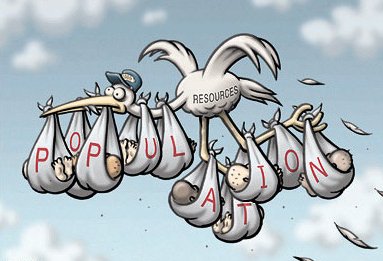Item Link: Access the Resource
Author(s): Bill Schlesinger
I can think of no subject related to the environment that garners more heated debate than the suggestion that we should curb human population growth. It gives immediate rise to accusations of racism and elitism. For many, it flies in the face of God’s Biblical orders to be fruitful and multiply. For others, it repudiates the basic tenet of Darwinian evolution that the fitness of organisms is based on the number of offspring left behind. And many simply don’t want to discuss a subject that is so personal and private as human reproduction.
Those who reject the importance of population as an environmental issue stress that resource consumption rather than population size has led to our current global environmental impact. True, resource consumption is central, leading to perhaps two thirds of the growth in carbon dioxide emissions in recent decades. But, resource use begins with the first diaper slapped on a new born infant and ends with the last blast of natural gas for a cremation. The child not born uses no resources.
Decades ago, John Holdren and Paul Ehrlich codified the human environmental impact in the multiplicative equation I = P x A x T, where P is population size, A is affluence and T is technology. They recognized that technology might sometimes reduce or modify impact, as when the discovery of illuminating oils led to a shift away from hunting whales. But, the positive confounding of population multiplied by affluence (as a measure of resource use) renders moot the “one-or-the-other” argument about the causes of environmental impact, that generates so much more heat than light in current debate.
No one will advance with the argument that we should embrace a lower standard of living for any person living on any continent. To improve efficiency at lower cost, we may substitute solar power for coal, electric- instead of gasoline-powered vehicles, and LEDs for incandescent lights. But, we will not replace the basic need for space for human occupancy and food for them to eat.
There is a finite amount of land available, fertile soil, and photons that fall on it, which will determine the habitat and food supply for humans at the expense of the rest of the Earth’s biodiversity. Somehow many of us find it easy to overlook the role of growing human population in the loss of a local woodlot in favor of suburban development and for the increasing demand for food that destroys Amazonian rainforests.
There are now 7.8 billion humans on planet Earth, each in pursuit of the good life. Economists love population growth that factors into traditional measures of economic growth. With each increment of GDP, our rising numbers extract more materials from the Earth’s crust and cast more effluents into its atmosphere and oceans.
We can hope that innovation may further lower resource use per capita, but It is not as if the new additions to our population will not consume resources. And, with more of us, the impact on the environment will grow. Talk of sustainability is hollow when the human population on the planet is growing at 1% each year—doubling every 67 years. Only with a population growth rate of zero might we have some hope for planetary stability.
In addition to the points raised in this article, the MAHB believes we need to reduce the overall world population and that we must acknowledge the exponential impact counties such as the US have (because of their extremely high consumption habits) thus having larger responsibility to address the issue.
This blog was originally published here.
The views and opinions expressed through the MAHB Website are those of the contributing authors and do not necessarily reflect an official position of the MAHB. The MAHB aims to share a range of perspectives and welcomes the discussions that they prompt.

